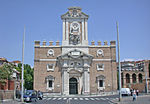Museum of Contemporary Art of Rome
1999 establishments in ItalyArt museums and galleries in RomeArt museums established in 1999Contemporary art galleries in ItalyEuropean art museum and gallery stubs ... and 4 more
Italian art stubsItalian museum stubsRome Q. IV SalarioUse British English from March 2014

The Museum of Contemporary Art of Rome, Italian: Museo d'Arte Contemporanea di Roma, usually known as MACRO, is a municipal contemporary art museum in Rome, Italy. The museum is housed in two separate places: a former brewery in Via Nizza, in the Salario quartiere of the city; and a former slaughterhouse in Piazza Orazio Giustiniani, in the quartiere of Testaccio.
Excerpt from the Wikipedia article Museum of Contemporary Art of Rome (License: CC BY-SA 3.0, Authors, Images).Museum of Contemporary Art of Rome
Via Nizza, Rome Salario
Geographical coordinates (GPS) Address Nearby Places Show on map
Geographical coordinates (GPS)
| Latitude | Longitude |
|---|---|
| N 41.9136 ° | E 12.5028 ° |
Address
Via Nizza
Via Nizza
00198 Rome, Salario
Lazio, Italy
Open on Google Maps







